This guide will delve into the intricate workings of food in Space Haven, aiming to help you make the most efficient meals. If you’re not too concerned about maximizing every detail and just want to enjoy the game, feel free to skip this guide – it won’t affect your gameplay. Please note that the information provided here is accurate for Alpha version 0.17.5 يبني 2 of the game.
So What’s for Dinner?
In the vast universe of Space Haven, there are an astounding 59,403,777 unique combinations of ingredients like fruit, root vegetables, artificial meat, nuts and seeds, monster meat, and even human meat, all deemed valid by the game’s standards. These combinations work as long as the total “food value” of the meal falls within the range of 75 ل 150. But how do you determine which of these 60 million meals is the best for your crew, and what exactly is this “food value”?
For smaller crews, typically around 15 members or less, a straightforward approach is to experiment with meal combinations and adjust as you go. In such cases, minor inefficiencies usually won’t significantly impact your gameplay.
لكن, if you’re ambitiously constructing an endgame megaship housing 50 or more crew members, inefficiencies become crucial. The primary challenges you’ll encounter are the sheer number of grow beds required to sustain your crew and the immense amount of water needed for food production. Unless you want to spend your entire game searching for ice and covering half your ship in grow beds, understanding the mechanics behind the food system becomes vital for optimization.
It’s important to note that in this guide, we focus solely on meals created from combinations of fruit, vegetables, لحمة, and nuts, ignoring monster and human meat. These are omitted not only because they are less nutritious but also due to the limited and unsustainable sources of these meats in any given map. بعد كل شيء, the galaxy has a finite number of warm (and cold) bodies. It’s a somewhat macabre thought that you could technically consume every being in the entire galaxy. But if you’re seeking guidance on toxins and vomiting on a large scale, you won’t find it here.
Nutrient and Food Values
Both raw and cooked foods contain varying amounts of protein, carbohydrates, fat, and vitamins. بالإضافة إلى ذلك, there’s a concept called “food value” that is entirely derived from these nutrient values. Think of “food value” as a bit like calories but with a different conversion rate in an alternate universe. Specifically, protein and carbohydrates contribute 2 food value each, while fat adds 3 food value. Vitamins, على الجانب الآخر, don’t contribute to food value but are still important to track as essential nutrients.
To see this in action, you can simply perform some math. In most cases where you encounter information about protein, carbohydrates, and fat content, you can multiply each of these values by 2 (for protein and carbs) أو 3 (for fat), and then sum them up. This sum will correspond to the associated food value. على سبيل المثال, using the kitchen settings provided, a full crate of root vegetables contains 2 units of protein, 110 units of carbohydrates, و 3 units of fat.
(2 × 2) + (110 × 2) + (3 × 3) = 4 + 220 + 9 = 233
This matches the food value displayed.
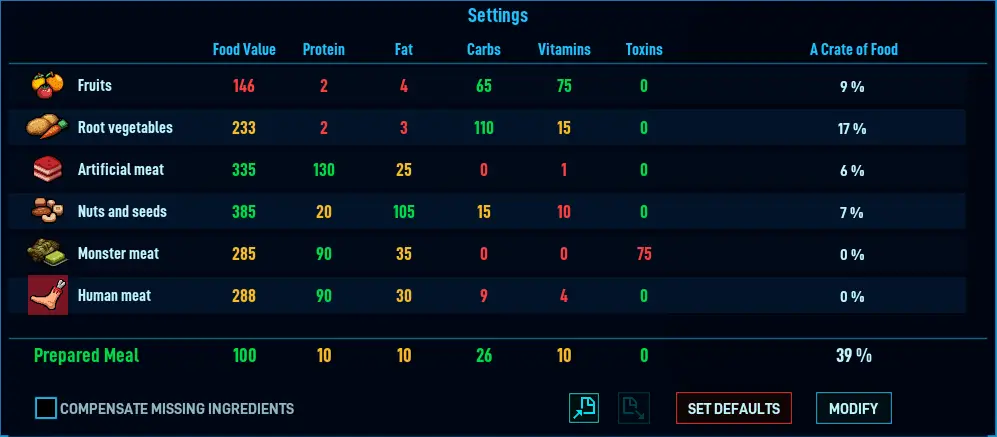
It’s worth highlighting that while the kitchen’s user interface displays protein, carbohydrate, and fat values as whole numbers for a full crate of raw food, this is an exception rather than the norm. Internally, all values are tracked using real numbers, including fractions. نتيجة ل, the numbers you see in the UI often don’t seem to add up precisely. Let’s take the default meal as an example, consisting of 9% fruit, 17% vegetables, 6% لحمة, و 7% nuts, which claims to provide 10 protein, 26 carbs, و 10 fat. لكن, if you calculate it:
(10 × 2) + (26 × 2) + (12 × 3) = 20 + 52 + 30 = 102
This doesn’t match the displayed food value of 100. The reason for this discrepancy is that the UI generally rounds values to the nearest integer and doesn’t display fractional numbers. In reality, the default meal contains 9.72 protein, 25.6 carbs, و 9.72 fat, totaling a food value of 99.8 since it’s composed of fractions of food crates. I won’t delve into the detailed math here, but the provided screenshot contains the necessary information to do this calculation if you’re interested.
الآن, the crucial point here is that the game’s internal operations primarily revolve around protein, carbohydrates, and fat. The food value is derived from these values as needed, mainly for display purposes in the UI. The significance of this will become clearer in the following section.
Digestion
On the crew member status screen, if you click on the food bar, it opens up a detailed page with two main sections: one for the contents of the crew member’s stomach and another for the stored nutrients in their body. Each of these sections shows the levels of protein, carbohydrates, fat, and vitamins. The numbers displayed next to “stomach” و “stored” at the top simply represent the calculated “food value,” as discussed in the previous section.
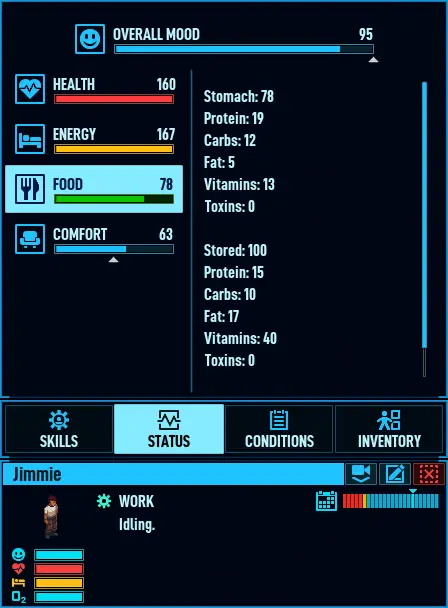
When a crew member consumes a meal, the protein, carbohydrates, fat, and vitamin values from that meal are added to whatever nutrients were present in their stomach. If their stomach was entirely empty before eating, then after the meal, the nutrient values here should match those of the meal they ate.
The nutrients in a crew member’s stomach are gradually digested over several hours and are fully transferred to their stored nutrients without any efficiency losses, unlike real life. The time it takes for this digestion process varies, depending on the size and composition of the meal. بشكل ملحوظ, protein and carbohydrates take 50% longer to digest than fat, according to the game’s formula. This means that meals with higher protein and carbohydrate content tend to keep the crew member feeling “full” for a longer duration.
The internal game formula for calculating the digestion rate is somewhat complex because it aims to ensure that uneven amounts of protein, carbohydrates, and fat are all digested down to zero at approximately the same time. Since fat digests at a different rate than protein and carbohydrates, this results in a slightly nonlinear digestion rate for the individual nutrients, as illustrated in the provided graph. The curve is subtle, but it means that different meals with the same “food value” will take different amounts of time to digest, depending on their nutrient composition.
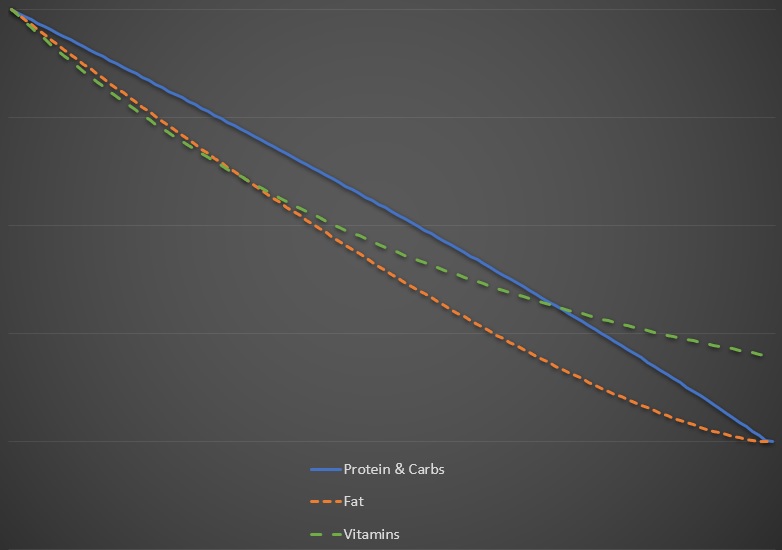
The digestion speed of vitamins, لكن, operates independently of the other nutrients and follows a nonlinear formula. This formula results in a relatively slow digestion rate for vitamins, which is why you might often still find vitamins in a crew member’s stomach long after the other nutrients have been digested. This extended presence of vitamins in the stomach is beneficial because it means that the crew member will have a higher vitamin level than what the last meal provided when they eat their next meal. This stacking effect continues until an equilibrium is reached with the digestion rate. The overall consequence of this is that crew members recover from vitamin deficiencies more rapidly if they consume regular meals.
As a final note, to complete the digestive cycle, the frequency of crew members using the toilet is influenced by the nutrient composition of the meals they consume. Meals rich in protein lead to more frequent toilet usage, while those high in fat result in less frequent toilet trips. The frequency can vary from occurring after every meal to as infrequently as once every 3 meals in extreme cases. This is important because using the toilet reclaims a significant amount of water, much more than what’s obtained from composters or water collectors. The more often crew members use the toilet, the less net water is required for growing food and producing oxygen.
Metabolism
In addition to the ongoing digestion process, crew members continuously metabolize their stored nutrients to sustain their bodies. Every 10 minutes of game time (which corresponds to 10 seconds on the slowest speed setting), a fixed quantity of protein, carbohydrates, fat, and vitamins is consumed from the crew member’s stored nutrients. This metabolic process occurs regardless of the crew member’s activity (whether they are working, resting, or sleeping) and is independent of their health or other conditions. It’s important to clarify that there’s a common misconception that more nutrients are expended when crew members are working compared to when they are at rest, but this is not the case.
Each in-game day, crew members burn through 5 protein, 10 carbohydrates, 5 fat, و 10 vitamins. لو, on average, they consume less than these amounts over a 24-hour period, they will eventually develop one or more nutrient deficiencies.
It’s noteworthy that the metabolism rate is always slower than the digestion rate, regardless of the type of meal consumed. This means that stored nutrients will consistently increase while a meal is being digested, even though stored nutrients are simultaneously being utilized by the crew member’s metabolism.
As for the maximum levels of nutrients that can be stored, هم كذلك 15 units of protein, 10 units of carbohydrates, 16 ⅔ units of fat (rounded up to 17 in the UI), و 40 units of vitamins. Once these levels are reached, any additional digested nutrients beyond these limits are lost.
Nutrient Deficiencies
Nutrient deficiencies are debuffs that have a chance to be applied every 100 دقائق, whenever a crew member’s stored protein, carbohydrates, fat, and/or vitamins drop below a value of 1. The attribute penalties for each nutrient deficiency debuff are shown in the table below.
These debuffs do not stack, however they won’t be removed until the corresponding stored nutrient value goes back above 5. Note that this can be difficult to gauge from the UI, since displayed values are rounded to the nearest integer. على سبيل المثال, if a nutrient value is raised back up to 4.75, the UI will display a value of 5, but the debuff will not be removed.
Nutrient deficiencies are most commonly caused by not eating meals with a good nutrient balance for an extended period of time. They can also be caused by missing several meals in a row. Assuming a crew member’s nutrient stores are at their maximum values, the table below shows how long the crew member would need to go without eating to have a chance of developing a nutrient deficiency.
When meals served to crew members contain less than the required daily intake of 5 protein, 10 carbohydrates, 5 fat, و 10 vitamins that their bodies metabolize, you can estimate how long it will take for a nutrient deficiency to develop by multiplying the durations mentioned earlier by the percentage of the deficiency.
In the early and mid game stages, nutrient deficiencies can be quite common until a stable and reliable food supply is established, especially if you’re relying on algae dispensers. Once a consistent food source is secured and well-balanced meals can be consumed regularly, the primary cause of nutrient deficiencies becomes missed meals due to crew members being drafted during their rest breaks. Depending on the type of meal being served and the crew member’s schedule, this issue often self-corrects when the crew member is able to eat again. لكن, in extreme cases where meals provide only the bare minimum daily nutrients or if rest periods are infrequent, you may need to temporarily adjust the crew member’s schedule to allow them to consume an extra meal to prevent nutrient deficiencies from occurring.
Food That’s Not From the Kitchen
Aside from the meals your crew prepares at the kitchen, there are several other sources of food in the game. Some of these might not seem like “طعام”, but they do add nutrients to the crew members’ stomachs just like prepared meals do. Each of these is shown in the table below, along with the nutrients they provide.
ملحوظات:
- The values above are for Processed Food that is salvaged, looted, bought, or traded for. Processed Food cooked by crew members at a kitchen will have the nutrient values shown in the kitchen settings.
- “Backer Beer” is only produced by the special Alcohol Beverage Machine that was a Kickstarter backer reward.
- IV Fluid is administered when a crew member is resting in a medical bed.
This information is provided for completeness, but as a rule you don’t want to make a habit of eating these things. In particular, beer uses up a lot of water for very little return in terms of increasing mood. You also have a 50% chance to get a “hungover” debuff that negates the mood buff from being intoxicated, so all you’re left with is attribute debuffs in both cases.
Space Food could be an exception to this, since just one of these will completely cure any nutrient deficiencies a crew member has. لكن, the game currently provides no way to force a crew member to eat a specific meal (without an insane amount of micromanagement disabling kitchens and changing storage settings). You’re better off just scheduling them some extra rest time once their stomach is below 40, and having them eat an extra meal from the kitchen.
Note that crew members can also eat raw fruits, vegetables, لحمة, and nuts directly from storages. Don’t do this. They can only eat an entire crate of food at a time, which causes them to massively overeat. It’s also incredibly wasteful, and doesn’t provide balanced nutrition. Make sure to select the toggle in the settings for each storage that prevents crew members from eating directly from them.
Hunger and Overeating
Aside from nutrient deficiencies, which shouldn’t happen unless something is really wrong, there are two main conditions that can affect your crew that you need to be aware of.
أولا, it’s actually possible to overeat. Whenever the “food value” in a crew member’s stomach is above 120, every 30 minutes of game time there is a chance for a stacking “ate too much” debuff to be applied. This can happen either from eating a meal with a food value over 120, or by eating a meal when their stomach wasn’t empty yet and the new resulting total is over 120. This debuff can stack up to 3 مرات, and applies the following debuffs:
The overeating debuff isn’t crippling, but the energy and working speed penalties can be significant at larger stack sizes. Individually they may not look that bad, but together they really reduce the overall productivity of crew members. That’s because the energy debuff causes crew members to take rest breaks more often, and the working speed debuff means they get less done when they are working.
The bigger issue is that this debuff goes away rather slowly. Once the “food value” in a crew member’s stomach is below 100, every 6 minutes of game time there is a فرصة to remove one application of the debuff. That doesn’t seem so bad, but if the crew member has significantly overeaten then it could take as long as 4 hours to drop below the required 100 food value threshold, and then you have to wait for the RNG to start removing it.
On average, expect this debuff to stack 1-2 times and last for around 3-4 ساعات.
ثانية, being hungry is not without penalty. إذا “food value” in a crew member’s stomach is below 20, every 30 minutes of game time there is a chance for a stacking “feeling a little hungry” debuff to be applied. This can stack up to 5 مرات, and applies the following debuffs:
The attribute debuffs are fairly minor, but the mood debuff can get quite high if the crew member is hungry for long enough. لحسن الحظ, this debuff goes away very quickly once the crew member eats a meal. Once the “food value” in a crew member’s stomach is above 20, every 10 minutes of of game time one application of the debuff is removed (guaranteed). This means all the debuffs will go away soon after eating, often before the crew member’s rest break ends and they have to go back to work.
On average, expect this debuff to be applied roughly once every 2-3 ساعات, which means it takes a fairly long time to reach a full stack.
Great Meals
في اللعبة, there’s a beneficial buff called “ate a great meal,” and it’s triggered when a crew member consumes a meal comprising three or more different ingredients. على سبيل المثال, a meal containing fruit, vegetables, and meat qualifies as a great meal, whereas a meal made solely from vegetables and nuts does not. It’s advisable to aim for meals with at least three ingredients to ensure this buff.
ال “ate a great meal” buff boosts a crew member’s mood by 5 for a duration of 12 ساعات, and it doesn’t stack. Importantly, it doesn’t reset either. This means that if you already have the buff, but it only has one hour left, and then you eat another great meal, the buff will still have only one hour remaining. لمنع هذا, you should ensure that more than 12 hours elapse between meals.
It’s worth noting that “Space Food,” despite having excellent nutrient composition, does not grant the great meal buff. بصورة مماثلة, any “Processed Food” obtained through salvage, looting, شراء, or trade also does not provide this buff. The great meal buff exclusively comes from food prepared in the player’s kitchen.
Timing Is Everything
The main challenge in optimizing the food system lies in managing buffs and debuffs. To keep your crew performing at their best, it’s crucial to consume the right amount of food at the right times to avoid negative effects. A key factor in meal optimization is understanding how long it takes for food to digest, as this determines the intervals between meals and prevents overeating. It also influences how long crew members can go between meals without experiencing significant hunger or nutrient deficiencies.
لكن, it gets even more complex. Crew members aim to eat during their scheduled rest times when their stomach’s “food value” drops below 35 (أو 40 if their schedule has been adjusted). لذلك, you must carefully set the time between rest periods to ensure crew members don’t eat before their previous meal has been fully or mostly digested. Eating on a non-empty stomach risks debuffs from overeating.
من الناحية المثالية, crew members should eat no more frequently than every 12 hours to consistently benefit from the great meal buff.
Reflecting on these points, you’ll realize that the “optimal meal” depends entirely on your crew’s schedule. What’s best for one schedule may not work for another. للأسف, finding a meal that suits your specific schedule can be quite challenging, if not impossible. In the quest to optimize your meals, it’s often the meals themselves that dictate your schedule, rather than the other way around.
Going With the Defaults
To see all of this in action, let’s take a closer look at the default meal, when paired with the default schedule. Both are shown below for reference.


The default meal takes 15 hours and 10 minutes to completely digest, and lasts 11 hours and 50 minutes before crew members start being subject to hunger debuffs. The soonest a crew member will (عادة) be interested in eating is 9 hours and 30 minutes after their previous meal.
The default schedule has alternating 17 و 7 hour intervals between meal opportunities. This means that if they eat in the morning, they’ll be hungry again in the evening. If they eat in the evening, they normally wouldn’t be ready to eat again in the morning. لكن, there’s an internal game mechanic where crew members will attempt to eat immediately after waking up if they have rest time scheduled and the “food value” in their stomach is below 60, which usually results in overeating.
The default meal and default schedule don’t work together well, and result in a lot of debuffs being applied. Over the course of 3 days, here’s how the crew members will fare if they start with empty stomachs:
To address the issue of days 2 و 3 repeating indefinitely, it’s crucial to make a change. A practical solution is to adjust the crew’s schedule so that they have a designated rest period every 8 ساعات. This modification will lead to them consuming this particular meal once every 16 ساعات, and they will experience hunger debuffs for approximately 4 hours and 10 minutes before their next meal. While this isn’t ideal, it’s a better alternative than overeating, and it should result in only 1 أو 2 instances of the hunger debuff each time.
The key lesson to learn here is the importance of harmonizing your schedule with your meal choices. This synergy between schedule and meal selection is vital for minimizing food-related debuffs as much as possible.
Flawless Victory?
So given everything above, is it possible to completely avoid food related debuffs? In theory, نعم. In reality, no. But let’s try anyway.
Technically there are a small number of meals (755 to be exact) which, if scheduled properly, can result in always having between roughly 25 و 115 food value in the crew member’s stomach — just missing the debuff cutoffs on either side. The most efficient of these, in terms of grow beds, ماء, and fertilizer required to grow the meal, is shown below along with the schedule required to make it work.
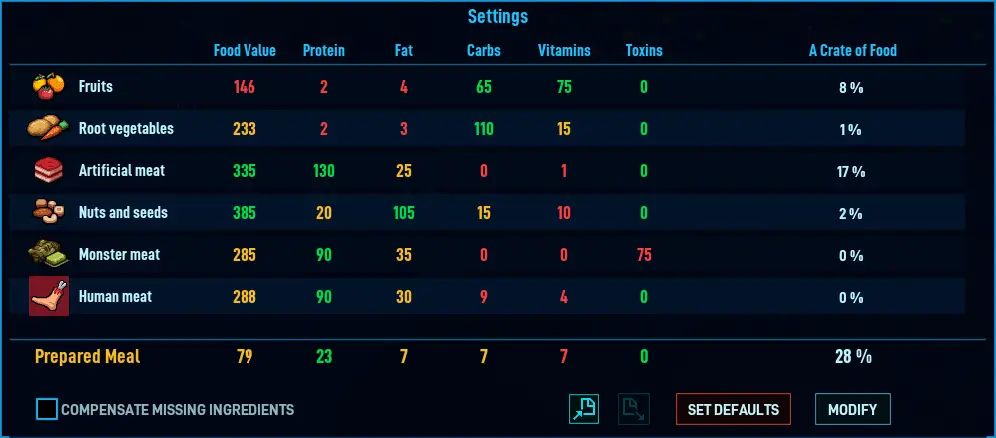

One glaring issue with this approach is the complexity of the schedule required to make this meal work effectively. The reason for this complexity is that meals like the one described involve a multi-step process: eating once to prepare the stomach, eating again at a specific interval to fill the stomach without overeating, and then maintaining that fullness with subsequent meals.
In the case of the meal mentioned, it takes 12 hours to digest and can be consumed again after 8 hours without overeating. It sustains a crew member for 9 hours until their stomach’s “food value” drops below 20. Consequently, the schedule needs to accommodate both 8-hour and 12-hour intervals for eating. The only way to make this work without constant manual intervention is to schedule rest periods every 4 ساعات.
It’s worth noting that, in this scenario, it’s necessary to schedule at least one hour of work immediately after the sleep period. This is because crew members tend to attempt to eat right after waking up if they have rest time scheduled and their stomach’s “food value” is below 60 (less than half full). لمنع هذا, you must ensure they don’t eat immediately upon waking to avoid overeating.
This schedule can be adjusted by shifting it by 6 ساعات, allowing for staggered shifts and requiring only one bed for every 4 crew members. لكن, this is one of the few advantages of this approach.
إجمالي, this schedule is highly inefficient as it causes crew members to constantly move back and forth to the leisure area. بالإضافة إلى ذلك, this meal plan guarantees that crew members will eat twice per day, making it less efficient in terms of resource usage compared to the default meal plan (assuming the modified schedule with rest breaks every 8 hours is used). Although it requires less water to grow the ingredients, it still has its drawbacks.
لذا, while it may avoid debuffs, it does come with its own set of challenges and inefficiencies.
Failure Is the Only Option
It’s time to face a harsh reality: it’s impossible to completely avoid food-related debuffs. If you had a hunch about that, consider your instincts correct.
The main issue with the “ممتاز” meal plan from the previous section (and similar ones) is that it leaves virtually no margin for error. Crew members must make it to the kitchen on time for every meal, without fail. If they’re late for any reason and miss a meal, they’ll end up with hunger debuffs. This could happen because they were drafted, their mining pod took longer than expected, they were engrossed in refining an energy rod, or even because they needed a bathroom break – everyday occurrences entirely out of your control.
These mishaps aren’t rare; they happen regularly. The only way you could somewhat reliably avoid this is if your crew did nothing but hang out by the kitchen and sleep. Even if you somehow managed to prevent all these issues, كما ذكر سابقا, the specific schedule required to make these meals work is highly inefficient.
Timing can also work against you. If a crew member is slightly late for one meal and on time for the next, slightly less than 12 hours will have passed between meals. This prevents the “ate a great meal” buff from being applied. ال “ممتاز” meal plan (and similar ones) only work on a strict 12-hour schedule, so in the worst case, you might only have 50% uptime on that buff.
It would be fantastic if there were a way to completely avoid these problems without introducing massive inefficiencies or requiring excessive micromanagement, but currently, that’s not possible. This is somewhat understandable since the game leans more toward survival simulation rather than a leisurely cruise.
Given the impracticality of 100% debuff avoidance, the next best approach is to find ways to keep these debuffs at a predictable and manageable level. This opens up more possibilities and allows us to truly optimize food usage.
Hunger is Your Friend
As mentioned earlier, the overeating debuff is generally worse than the hunger debuff. Overeating drastically reduces crew productivity, necessitating more crew members to maintain the same level of work output, which in turn requires more food production. This is the opposite of our goal.
In contrast, the hunger debuff is mostly benign. Its attribute penalties are minor, and it disappears almost immediately after eating. The primary concern with the hunger debuff is its mood penalty, which can reach -25 if left unattended for too long. So the real challenge here is preventing it from escalating.
Enter the “ate a great meal” buff. With its +5 mood boost lasting for 12 ساعات, it acts as a counterbalance to the mood penalty caused by the hunger debuff. Essentially, it nullifies any long-term effects of hunger as long as the average mood penalty from hunger over a 12-hour period is -5 or less. This allows us to tolerate larger stacks of the hunger debuff than we would otherwise accept.
The Optimal 16-Hour Meal
To ensure we always get the “ate a great meal buff”, the interval between meals needs to be more than 12 ساعات. One way to accomplish this, without requiring an inefficient schedule, is to plan a meal that needs to be eaten every 16 ساعات. In order to ensure the crew members can recover on their own quickly from missed meals (without any micromanagement), we need to be able to schedule rest breaks every 8 ساعات, without any risk of them overeating.
هناك 83,435 meals that satisfy the criteria above, where the meal takes 16 hours or less to digest, but takes at least 9 hours to digest down to a food value below 35, and that won’t result in any long-term nutrient deficiencies. The most efficient of these, in terms of water and fertilizer required to grow the meal, is shown below along with the schedule required to make it work.
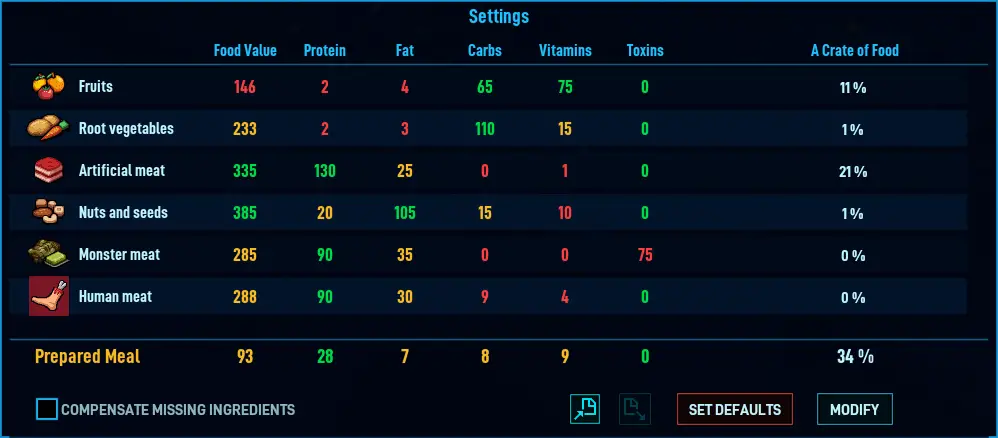

As previously mentioned, the game has a mechanic where crew members will try to eat immediately after waking up if they have rest time scheduled and their stomach’s “food value” is below 60 (less than half full). لذلك, we must ensure that there’s no rest time scheduled right after sleeping to prevent overeating.
بصرف النظر عن ذلك, this schedule follows a fairly standard pattern with three meal breaks spaced at 8-hour intervals. It can be shifted by 6 hours and overlapped, allowing for 4 staggered shifts, which means only one bed is needed for every 4 crew members, making it highly space-efficient.
Once consumed, this meal keeps crew members feeling full for approximately 11 hours and 20 دقائق. They experience hunger debuffs for the subsequent 4 hours and 40 minutes until their next meal. On average, this results in only 1-2 applications of the hunger debuff, resulting in a mood penalty of -10 or less and relatively minor attribute debuffs.
In terms of debuffs, this meal is comparable to the default meal when using the same schedule. لكن, it is more resource-efficient to produce, requiring 3% fewer grow beds, 76% less water, و 15% less fertilizer (assuming all biomatter is being composted). بالإضافة إلى ذلك, it generates 39% less biomatter than the default meal due to the high use of artificial meat. This means you’ll only need about 60% as many composters, saving even more space.
The most advantageous aspect of this meal is that it’s entirely maintenance-free. If a crew member misses a meal for any reason, the worst that happens is they might have a couple of extra applications of the hunger debuff. They will automatically feed themselves at the next meal break and quickly recover from any nutrient deficiencies that were starting to accumulate. Importantly, there’s no risk of overeating at any point.
The Minimal 24-hour Meal
The meal in the previous section is great if you want the freedom to draft crew members as needed, without having to worry about the consequences. But what if you’re willing to be a little more hands-on? And what if you don’t care about letting a full stack of hunger debuffs accumulate?
The longest you can make crew members go without a meal is 24 ساعات, because that’s the limit of the scheduling tool. The schedule used for any 24-hour meal is the one below.

So what are you looking at here? 18 glorious uninterrupted hours of work time, which is the most you can possibly get while still getting enough sleep. In this case we will schedule the rest time directly after sleeping, to ensure the crew members always eat before starting their day. This also ensures no meals will be missed (unless crew members are drafted), because it should never take them more than an hour to walk from their beds to the kitchen.
As before, this schedule can be shifted by 6 hours and overlapped, allowing for 4 staggered shifts. This in turn means that only one bed is needed for every 4 crew members, making it very space efficient. It also has the additional benefit of ensuring 75% of your headcount is on an active work shift at all times.
So what about the meal itself? As it turns out, هناك 72,733 meals that provide enough nutrients to be eaten only once per day, without developing any long-term nutrient deficiencies, and still have under 120 food value so they don’t result in overeating. That’s a lot to choose from. Let’s start with the absolute most efficient meal, in terms of grow beds required, as shown below.
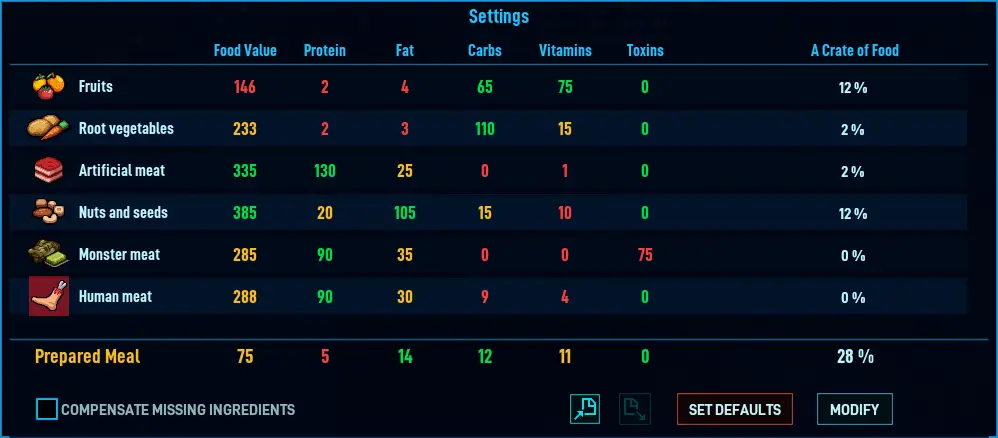
The main issue with this meal is that it’s very high in fat. This means the crew members will use the toilet much less frequently – only once every 3 meals – meaning you won’t be able to reclaim as much water. Compared to the optimal 16-hour meal, this requires 47% fewer grow beds and 42% less fertilizer, but requires 97% more water. (لكن, it still requires about half as much water as the default meal.) With this meal, you’re essentially trading water efficiency for space efficiency.
The other problem with the high fat content of this meal is that it doesn’t keep your crew members feeling full for very long. They will only feel full for 6 hours and 40 minutes after eating this meal, which means they’ll be subject to hunger debuffs for 17 hours and 20 دقائق. This pretty much guarantees a full stack of hunger debuffs, ل -25 mood penalty. If you’re in the endgame and have comfort maxed out in the rest/sleep areas, you can probably weather this without issues. But it’s something to be aware of.
The other option is to aim for the best possible water efficiency, which you get from the meal below.
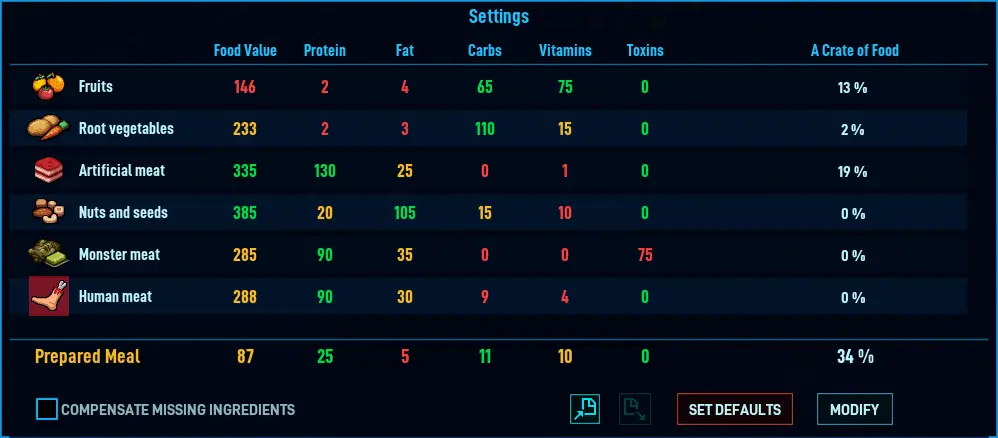
When comparing this meal to the optimal 16-hour meal, there are several advantages to consider. This meal requires significantly fewer resources, مع 36% fewer grow beds, 38% less water, و 32% less fertilizer needed. Although it does require 21% more grow beds than the previous 24-hour meal, the reduction in water usage makes it a more attractive choice, particularly for larger crews where space constraints are less of an issue. For every 10 crew members, you’ll need 3 large (5-bed) grow tables, which is manageable.
This meal is notably high in protein, keeping crew members feeling full for around 10 hours and 50 دقائق. لكن, they will still experience hunger debuffs for 13 hours and 10 دقائق, which is enough time to accumulate a full stack of hunger debuffs. لذلك, like the previously discussed meal, this one should only be used if all other aspects of your crew’s comfort are optimized.
The main drawback of both of these meals is that, while they are resource-efficient, they only meet the minimal daily nutrient requirements. If a crew member misses a meal due to being drafted during their rest time, they will have to wait a full day for another chance to eat. This can deplete their nutrient stores significantly, and since these meals don’t provide any surplus nutrients, it can take months to recover from such a deficit.
To address this issue, you must be vigilant when drafting crew members to ensure they don’t miss a meal. بدلاً عن ذلك, you can manually adjust their schedule after drafting to provide them with rest time to compensate for the missed meal. This problem typically arises with boarding parties or injured crew members in medical beds, as IV fluid doesn’t supply enough fat to cover a crew member’s daily metabolic burn rate.
Efforts to increase the nutrient content of these meals to mitigate this problem often counteract their space and resource efficiency without significantly reducing hunger debuffs. لذلك, using these meals requires some degree of micromanagement to maximize their efficiency. If you prefer a simpler approach, the optimal 16-hour meal mentioned earlier may be a more suitable choice.
Refugees and Prisoners
It can be tempting to treat refugees and prisoners as lower-priority individuals on your ship and have them rely on basic algae dispensers for sustenance. While this might suffice for a brief stay, it’s important to note that by the third day, they’ll already be facing a protein deficiency, and by the fourth day, they’ll also suffer from fat and vitamin deficiencies. Beyond this point, their mood will deteriorate rapidly, potentially leading to disruptive behavior like starting fires, which can be highly problematic.
Feeding proper meals to your refugees and prisoners isn’t just the humane thing to do; it can also be more resource-efficient, especially in terms of water consumption. علاوة على ذلك, it plays a crucial role in increasing your chances of persuading prisoners to join your crew if that’s one of your goals. لكن, the unchangeable schedule of refugees and prisoners presents a significant challenge.
Balancing the well-being of these individuals with your ship’s resources and security is a complex task. Ensuring they have access to nutritious meals is not only beneficial for their mood but can also contribute to a more stable and productive ship environment.

This schedule basically allows them to eat pretty much whenever they feel like it. Given that, the best meal you can feed them is the cheapest one, and that’s the second minimal 24-hour meal from the previous section:

They will fall into a pattern of eating this meal twice per day, which will prevent them from developing any nutrient deficiencies. Best of all, it will result in them using the toilet twice per day, so you’ll get a fair amount of water back out of them. If you’re composting all of their biomatter, this meal ends up costing 72% less water than an algae dispenser.
The only thing you’ll need to do extra is to keep a surplus of fruit, vegetables, and meat in your storages, so your refugees don’t eat all your crew’s food. It also means you might want to ensure your farms can slightly overproduce versus just what is needed to feed your crew, so you can replenish that surplus.
الأفكار النهائية
Exploring the intricacies of the Space Haven food system sounds like quite the journey! It’s fascinating to see how the game designers have incorporated both interesting quirks and thoughtful mechanics into it. The evolution of the game toward its 1.0 release promises even more exciting developments.
Your dedication to optimizing the system is impressive, especially with the transition from spreadsheets to a computer program capable of handling a vast number of permutations. While a web app might not be on the horizon for now, your insights and calculations are valuable to players looking to make the most of the game’s food system.
If there are any questions or further discussions on this topic, your willingness to share your knowledge and expertise in the comments is greatly appreciated. It’s evident that you’ve put a lot of effort into understanding and improving this aspect of the game, and your insights are likely to benefit other players as well.
هذا كل ما نشاركه اليوم من أجل هذا Space Haven مرشد. تم إنشاء هذا الدليل وكتابته في الأصل بواسطة spacedog. في حالة فشلنا في تحديث هذا الدليل, يمكنك العثور على آخر تحديث باتباع هذا وصلة.